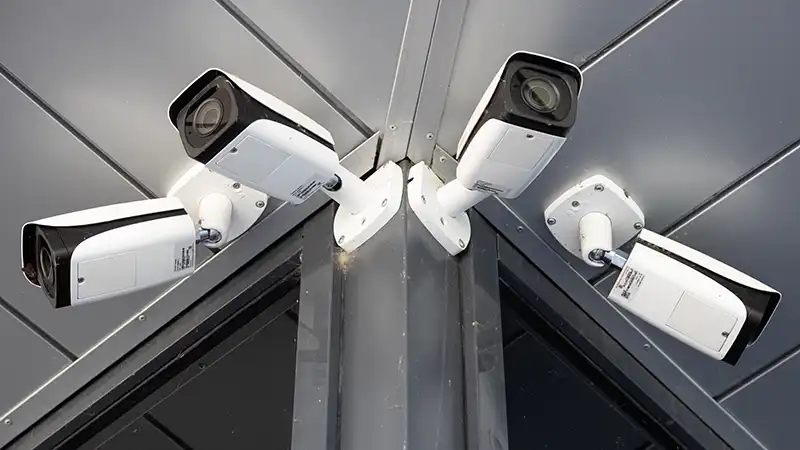Business security cameras are one of the most important tools for protecting your assets, but only if they're working properly.
Unfortunately, many businesses discover too late that their system has blind spots, footage gaps, or grainy video that's useless in a critical moment. Others struggle with cameras going offline without warning or find it takes forever to retrieve footage when it's needed most.
Sound familiar?
Even with a decent setup, business security systems can fail if they're not planned, configured, and maintained correctly. And while some issues are caused by aging equipment, many are preventable with the right know-how.
In this article, we'll walk through the most common issues business owners face with their security camera systems: what causes them, how to spot them early, and what to do about them.
Whether you're using a legacy system or have recently installed new CCTV equipment, this guide will help you protect your investment and peace of mind.
1. Blurry or Grainy Footage
Blurry or grainy footage is one of the most common problems with business security cameras, and one of the most frustrating. Whether it’s a face, a license plate, or a transaction, poor video quality can leave you without crucial information.
Why It Happens
-
- Low-resolution cameras. Older or budget models may not capture enough detail.
- Poor lighting. Dim areas or high-contrast scenes can confuse the camera sensor.
- Dirty lenses. Dust, smudges, or weather buildup can obscure the image.
- Compression settings. Some systems reduce video quality to save storage space.
How to Prevent or Fix It
-
- Choose at least 1080p resolution cameras for most indoor/outdoor needs.
- Ensure adequate lighting in key coverage zones, especially entrances or cash-handling areas.
- Set up a regular cleaning routine or schedule professional CCTV camera maintenance to clean all exterior lenses, particularly those in dusty, rainy, or high-traffic environments.
- Talk to your AV provider about optimizing compression settings to balance quality and storage.
Tip: Don't immediately assume your camera is bad. Start by cleaning the lens and checking your resolution settings first.
2. Frequent Connectivity or Power Issues
Cameras that randomly go offline, drop their connection, or reset during peak hours can leave dangerous gaps in your coverage and cause headaches for your team.
Why It Happens
-
- Unstable Wi-Fi or network interference. This is especially common with wireless camera setups in busy or signal-blocked environments.
- Improper power supply or loose cabling. A weak or inconsistent power source can cause random shutdowns or reboots.
- Overloaded PoE switches. If too many cameras draw more power than the network equipment can handle, you may get drops or lag.
How to Prevent or Fix It
-
- Use hardwired Ethernet connections where possible for reliability.
- Upgrade to Power over Ethernet (PoE) systems with properly rated switches and power budgets.
- Have your AV provider inspect and test cabling to rule out voltage drops or damaged connectors.
- Set up automatic alerts when a camera goes offline so you can troubleshoot quickly.
Tip: Even one camera going offline at the wrong time can create blind spots. Don't ignore those occasional dropouts, as they're often early warning signs.
3. Gaps in Recording / Missing Footage
You might have gone to review footage from a specific time only to find the camera didn't record it. It's one of the most frustrating issues business owners face, especially after an incident.
Why It Happens
-
- Storage is full. Once your system runs out of storage, it may overwrite older footage or stop recording altogether.
- Improper motion settings. If motion detection is too sensitive or insufficient, key events might not be recorded.
- System misconfiguration. Some systems default to manual or scheduled recording modes without your team realizing it.
- Overloaded NVR/DVR. Older or underpowered systems can miss data if they manage too many camera streams simultaneously.
How to Prevent or Fix It
-
- Ensure you have adequate storage for your retention needs (typically 14–30 days minimum).
- Review your motion detection zones and sensitivity settings to avoid false positives or missed events.
- Regularly audit recording schedules to ensure your cameras are set to continuous or event-based recording, depending on your needs.
- Consider upgrading to a modern NVR (Network Video Recorder) or cloud-based CCTV system if your current recorder is at capacity.
Tip: Schedule a monthly test where you intentionally trigger motion and review the footage. It's a quick way to catch problems before they matter.
4. Footage is Hard to Access or Retrieve
You know the incident happened. The cameras were on. But when it's time to pull the footage… no one knows how. Or the process takes too long to be useful.
Why It Happens
-
- Outdated systems with clunky interfaces or limited search tools.
- Footage is saved locally with no remote access (especially frustrating for multi-site businesses).
- No clear roles or training on how to retrieve or download footage.
- Inconsistent labeling or storage practices that make it hard to find the right date, time, or camera angle.
How to Prevent or Fix It
-
- Upgrade to a user-friendly interface with intuitive search and playback tools.
- Use systems that allow remote access, especially if you manage multiple locations.
- Assign and train specific team members to retrieve footage. Don't leave it to guesswork in a time-sensitive moment.
- Consider cloud-based or hybrid storage options that simplify long-term archiving and access from anywhere.
Tip: If it takes more than 2 minutes to pull footage, it's time to simplify your system or retrain your team.
5. Blind Spots and Poor Coverage
One of the most common (and costly) mistakes in business security setups is assuming "more cameras" means "better coverage." But, even with 10+ cameras, it's easy to miss critical zones if the placement isn't strategic.
Why It Happens
-
- DIY installations that prioritize easy mounting over sightline planning.
- No coverage overlap between key angles (entrances, registers, parking lots, etc.).
- Improper field of view. Either too wide (missing detail) or too narrow (missing context).
- Physical obstructions like displays, signage, or columns blocking camera views.
How to Prevent or Fix It
-
- Start with a professional camera placement audit based on your building layout and risk areas.
- Use a mix of wide-angle and zoom/PTZ cameras, depending on the coverage needed.
- Test playback from each camera to ensure critical areas (entrances, safes, exits) are visible and detailed.
- Periodically re-evaluate camera placement, especially after renovations, layout changes, or adding shelving or displays.
Tip: If you've had a security incident and couldn't "see what happened," it's time for a camera placement review.
6. Compatibility Issues With Existing Systems
Many businesses try to save money by adding new cameras or components to an old system, but end up running into a mix of reliability and integration problems.
Why It Happens
-
- Mixing analog and IP cameras without the right converter hardware or software.
- Outdated NVR/DVR systems that can't support newer high-res feeds.
- Locked into limited upgrades with current proprietary systems.
- Fragmented ecosystems where devices from different brands don't talk to each other.
How to Prevent or Fix It
-
- Before buying new cameras, get a compatibility check from an AV integrator.
- Avoid "piecemeal" upgrades without a long-term plan.
- If mixing analog and IP, use hybrid recorders designed for both.
- For larger sites, consider switching to open-platform systems that allow integration from multiple manufacturers.
Tip: A camera that technically connects but constantly glitches isn't a good investment. Ensure all your tech works together as a system, not as patchwork.
7. Security Risks (Unauthorized Access or Tampering)
Ironically, your security system itself could become a vulnerability if it's outdated or misconfigured.
Why It Happens
-
- Default usernames and passwords never changed after installation.
- Outdated firmware with known security vulnerabilities.
- Open remote access ports or weak network security.
- No user access controls, allowing anyone on your team to view, download, or delete footage.
These weaknesses can be exploited by hackers, former employees, or even curious staff, leaving your business exposed to data breaches or legal risks.
How to Prevent or Fix It
-
- Change all default login credentials immediately after installation.
- Keep firmware and software up to date to patch security holes.
- Work with IT or your AV provider to ensure secure remote access (VPNs, encrypted portals, etc.).
- Use role-based access controls so only authorized staff can review or manage footage.
Tip: Your security system is only as strong as its weakest password. Lock it down like you would your payroll or point-of-sale system.
What to Do if You're Seeing These Problems
If any of the issues above sound familiar, you're not alone. Better yet, you don't necessarily need to start from scratch.
Step 1: Don't panic or overreact.
Most problems with business security cameras can be solved with better configuration, small upgrades, or routine CCTV maintenance. A full system replacement is rarely the first (or best) solution.
Step 2: Schedule a professional audit.
A qualified AV provider like Carolina Georgia Sound (CGS) can assess your current setup, identify problem areas, and recommend practical fixes that match your budget.
Step 3: Prioritize your upgrades.
Start with what impacts performance or coverage most, like replacing outdated equipment, adding PoE switches, or improving camera placement. Many systems can be upgraded in phases, spreading out the cost and reducing downtime.
Step 4: Plan for future flexibility.
Consider moving toward cloud-enabled, IP-based systems that scale as you grow and allow for easier management across locations.
Tip: A short consultation can save you months of frustration and thousands in wasted spend.
Why Work With CGS?
At Carolina Georgia Sound (CGS), we believe your business security system should give you peace of mind, protect your people, and work exactly when needed.
That's why we help business owners:
-
- Diagnose system issues quickly and honestly
- Design smarter layouts for full, efficient coverage
- Integrate new components with existing hardware when possible
- Train staff on how to access and manage footage confidently
- Plan for future growth with scalable, modern solutions
Whether you need a full system upgrade or just a second opinion on why your business security cameras keep dropping offline, we're here to help.
Think your security camera system might be underperforming?
Book a free security system review with a CGS expert. Let's go over what's working, what's not, and make it so your security system works just as hard as you do.

